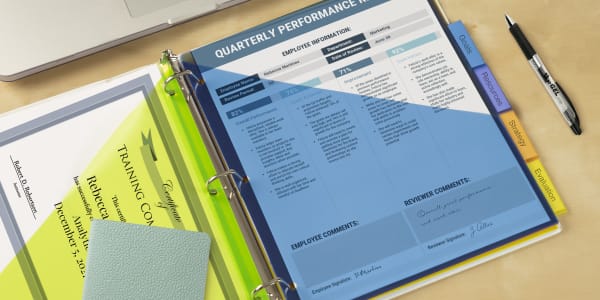

If you’ve never created a professional development plan (PDP), it may seem overwhelming. However, there are 5 basic elements that every PDP should include.
Whether you’re creating a PDP for yourself, or for folks you manage, the basic elements stay the same. In this article, we’re breaking down the basic elements with questions that help get the process flowing.
More articles you might like:
Professional development is not a one-time project. It’s an ongoing process of pinpointing and growing the skills needed to progress in any given career. It can include anything from working on skills at your own pace to attending conferences or taking training courses with certification.
Whether or not developing your skills gets you a promotion, every skill you add increases your value as an employee. Creating self-value is important for maintaining financial security. You simply never know when an extra set of skills is the difference between you and another employee.
Not to mention the sense of fulfillment and accomplishment from learning and developing new skills. That being said, professional development is also very important from an employer’s perspective.
Increased training budgets and rewards for employees that continue to upskill create a more stable organization. In other words, diverse training and skills better prepare companies for future disruptions.

If you’re serious about professional development, first and foremost, you must be honest with yourself. Take inventory of your skills and pinpoint areas that could use improvement as well as new skills that will prepare you for the next move in your career.
Indeed.com has a great article about how to write a self-evaluation that can help guide self-assessment. However, if you’re guiding professional development as a manager, it may be more helpful to perform a skills gap analysis.
In this instance, focus on job-specific skills. Ask yourself what skills your team actually uses on a daily basis. Identify strengths and gaps in both technical and soft skill sets.
Goal setting for employees you manage is sometimes easier than setting personal goals. Especially if your company has an organizational chart and defined job positions. Usually, management’s goals for professional development follow the flow of the organizational chart to advance employees towards higher positions.
When you’re creating your own professional development plan, setting your goals is the most personal part of the process. Life and your interests change, so your goals may change accordingly. It’s more important to be working towards something you really want, than stubbornly sticking to a goal you don’t care about.
In the end, aim high but be realistic. Be flexible and don’t be afraid to adapt your professional development plan in order to allow your goals to change with you.
For a personal PDP, lean on managers and mentors to provide you with the resources you will need to reach your goals. Ask your boss to be specific about what it will take to reach each goal or milestone. Ask your mentor what skills they were developing when they were at the same stage in their career.
When creating a professional development plan for employees, a little more research may be needed. Especially if you manage a team with diverse positions. Here are some ways to find resources for upskilling employees:
SMART goals are the perfect tool for defining the small steps in between larger goals laid out in a professional development plan. SMART stands for Small, Measurable, Attainable, Relevant, and Time-Based. These concepts used together create a framework that helps you apply time and resources towards progress.
Specific – a narrow goal makes the steps to success more clear
Measurable – how you will know you’re making progress toward your goal
Attainable – goals that can be reasonably accomplished (increases motivation and focus)
Relevant – each goal should align with the larger plan and long-term goals
Time-based – setting an end date helps prioritize steps towards larger goals
Professional development plans generally go hand-in-hand with performance reviews. Most businesses conduct end-of-year and mid-year reviews, so a good rule of thumb is to review PDP progress at the same time.
Employees should review their own professional development plans at least yearly. A great tip is to review your PDP during the month of your birthday. It’s technically the start of another year of your life and you can think of it as pampering yourself. You’re investing in your future and that should feel good!
Reviewing your personal PDP one to two times per year is a great choice as it matches the pace of most corporate evaluations. To really take it up a notch, review your PDP quarterly. While that may seem like a lot, there are two good reasons to do so.
Firstly, any professional serious about their career should be continuously documenting personal performance data. Such as projects you lead, training or certifications you completed, clients brought in, accounts won, etc. It’s harder to miss something if you’re reviewing data every three months.
Secondly, life happens. People get laid off, markets change, companies go bankrupt, networking pays off, etc. If you complete self-evaluations regularly for your PDP, you’ll never be caught off-guard for a job interview.
However often you complete self-evaluations, it's a good idea to immediately add your professional accomplishments to your Linkedin profile. Not only is it an easy way to keep track of data, but it's also a boost to your self-esteem knowing that you're not standing still.
In conclusion, professional development is an ongoing process for employees and managers alike. And there are different benefits for employees and managers creating a professional development plan.
For individuals, working through each element of a PDP increases your value as an employee and helps you gain better positions in your career. It can also help you maintain financial security and prepare you for unexpected job changes.
Companies that promote professional development create a diversified workforce that better prepares them for future disruptions. Additionally, managers can use PDPs to guide employees through the appropriate career path within the organizational chart.
Regardless, there are always 5 elements that every professional development plan should include. They are assessment, goals, resources, strategy, and evaluation. Whether you are working on a PDP for yourself or the people you manage, commitment to each element of the process is key.
Follow us on LinkedIn for more workplace discussions and networking with like-minded professionals.
JoAnn (JoJo) Mrgich is a copywriter and SEO content writer who began her copywriting career in 2011. A musical theater major at the time, JoJo began writing blog articles, product descriptions, and other online content for a dancewear brand. Since then, she has gone on to write in a variety of fields, from essential oils and natural beauty to fashion and swimwear, finally landing at Avery, which she affectionately calls her "forever home." At Avery, JoJo writes content for the Avery blog, covering everything from organization to party planning, as well as contributing to other online content for avery.com. She is also a technical and content writer for Avery Industrial, where she writes in-depth articles that span a wide variety of topics, from safety compliance to 5S lean practices. In her personal life, JoJo is a big fan of fantasy and science-fiction works such as Lord of the Rings and Star Trek (especially the original series). She also loves going to Disneyland and runs a non-profit social organization of 600 members that brings fans of "nerd culture" together for meet-ups and events in Southern California. View all posts by JoJo Mrgich